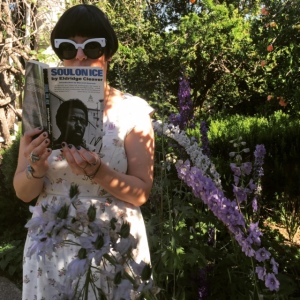
Happy birthday dear Seedy, CD, Clay. This is how I remember you. Wearing my coat, taking my clothes, reading my books, listening to my music. I remember dancing with you at Cats, watching movies with you and Randy, visiting Ronnie with you, going to Marcy Mendelon’s art show with you, you drinking with Fawn while I was in New Mexico at my grandmother’s funeral and you knocking a beer bottle into her face, chipping her front tooth. I remember how you offered to go to the funeral with me and you patiently walked me through the whole ritual. You asked me to bring you rain back from the desert and I did.
Tom Wolfe Disservices his Character Magdalena in Back to Blood

This is the fifth book I’ve read by Tom Wolfe. His journalistic style plus stories make for great page turners. Often his books explore class, wealth, and race—quite successfully. Back to Blood explored all those and more. I’m always a little weary when a white man writes about race and tend to read with breath held. I sometimes suspect that he is “stepping back and watching and reporting on those outside his world.” Sort of like the narrator on a nature program. The other three books of his that I read, The Bonfire of the Vanities, I am Charlotte Simmons, and A Man in Full all made sense and addressed people, dialect, and intentions with respect. In Back to Blood, most of it was good, almost all of it seemed quite well thought out and reasoned, but there was a character that just didn’t make sense to me. The lovely, intelligent, first generation Cuban American, Magdalena. She’s a nurse who ends up involved in the art world, specifically Art Basel of Miami.
Murderous Mermaids? Sure, because I trust Mira Grant aka Seanan McGuire
I don’t care for mermaids. Nor have I ever been interested in zombies. I have never wanted to read about diseases and outbreaks. And yet, I’m obsessed with Mira Grant. I am slowly working my way through everything she’s written. And she’s quite prolific. I never ever would have picked up her books if a friend hadn’t recommended her to me. The reason being I don’t really read scary books—I don’t like having nightmares. But her books are not horror at all. They probe what could happen if. . . . And sometimes what happens are dangerous situations that the average person is not prepared to handle. I know I most certainly am not. But after reading her books, maybe I would make it along a little farther in the story than the first person to die.
An Unintentional Literary Pilgrimage of Los Angeles
I’ve been to Southern California many times, and yet, I’ve never quite seen the Los Angeles that I wanted to. As a book nerd, I’ve always dreamt of doing a book tour, visiting famous literary sites. But Los Angeles County feels unwieldy. However, on this last trip, I lucked out. I stayed in downtown Los Angeles proper, with my friend, Erin Eyesore (check out her post-punk feminist radio show, erineyesore.tumblr.com). While she attended a conference for work, I did some sight-seeing. First on the list, The Last Bookstore which I’ve seen photos of on friends’ Instagram feeds. We were staying just blocks away from this heavenly place. It’s like the Cemetery of Forgotten Books in The Shadow of the Wind by Arturo Perez Reverte—you enter a noir bookstore, a space selling books in another realm, a fictional place that you wish existed—touching things seems unreasonable because they will flitter away in smoke because they exist in another dimension. But the labyrinth you wander is real and if you go on a slow day, which I did, you find yourself in mazes all alone, which of course, makes things more surreal.
Eldridge Cleaver’s Soul on Ice—Still Relevant 50 years later

Soul on Ice is comprised of different writings—essays, letters, and musings by Eldridge Cleaver, a former Black Panther Ministry of Information party leader. He writes about who he was, what he did, and why. He does not hide anything: his past actions, his past anger, his past crimes. He also writes about who he becomes, and from Folsom Prison he writes about being 18 years old in 1954, the “crucial turning point in the history of the Afro-American—for the U.S.A. as a whole—the year segregation was outlawed by the U.S. Supreme Court” (Cleaver, 3), which was when he started serving a sentence for possession of pot. This decision shaped what it was like “to be black in white America.” (Cleaver, 3)



